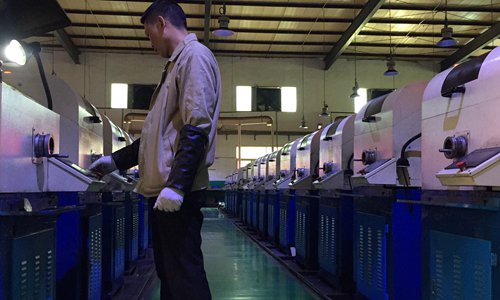
A worker handles a machine in a magnet factory in Dongguan, South China's Guangdong Province. Photo: Chen Qingqing/GT
In the past two years, I've traveled to Dongguan, South China's Guangdong Province three times. Every time, I was assigned to cover a different topic ranging from the replacement of workers with robots to the decline of the local GDP due to the crackdown on prostitution to how original equipment manufacturers (OEMs) thrive in the city.
No matter what kind of sources I talked with, I could not agree more that this manufacturing hub has been growing from the world's factory into a smart factory that will reshape industries and supply chains in South China's Pearl River Delta Region.
Western journalists care more about how many jobs have been replaced by robots in recent years and how many foreign-funded factories in Dongguan have been shut down because of the alleged deteriorating business environment on the Chinese mainland. It seems that they have ignored some basic factors involved in the industrial restructuring process.
When China unveiled economic reform and opening-up in 1978, foreign companies came to invest in China as a way of helping local industries. Some companies, which considered themselves contributors to China's economic growth, enjoyed a slew of favorable policies such as low tax rates and land use fees. Meanwhile, hundreds and thousands of factories have been set up in the Pearl River Delta Region, attracting migrant workers from all over China. Many are from rural regions, born and raised by poor families. And they wanted to change their destiny by working hard in those factories.
Some Chinese businesspeople, whom I interviewed during my days in Dongguan, shared the same path of becoming successful after spending years working in the region. Although some of them worked on simple tasks or assembled the same component day by day, they accumulated experience in doing repetitive work and left with the ambition to create their own business.
Some worked on really niche areas. They have been focusing on those areas for years and become experts on some technologies. For example, some make strong magnets with alloys of rare-earth elements. The product may be unremarkable, but can be used in many everyday domains including consumer electronic products such as smartphones and selfie-sticks. Another example is a businessman who has been making molds for several years in a factory set up on the mainland by a company from the island of Taiwan. Afterward, he then built up his own supplier network and started his own factory with just 6,000 yuan ($746) in the 1990s.
It is not a secret in Dongguan that some foreign-owned factories and enterprises have felt lost in recent years. As Chinese enterprises - boosted by technologies and skills learned from their foreign rivals - rushed into the global supply chain, foreign firms have been losing edge and becoming less and less competitive.
Some foreign representatives complained that the business environment in China has matured, with tightened rules and regulations on issues such as labor and environment protection. Others have pointed fingers at the so-called unfair business environment in the city, as their Chinese counterparts are believed to be raising funds more easily on the mainland, as a way of expanding their production scale. Foreign firms in Dongguan have felt less welcome because of the little privileges they can enjoy today.
In spite of the doubts about whether Dongguan, or the Pearl River Delta Region, can remain the global manufacturing hub, after some foreign companies fled to Southeast Asian countries for cheaper labor costs and more favorable policies, the region is moving forward.
A business veteran in the city told me that 10 years ago, if you hired hundreds of workers, other people believed that your business was competitive. Today, that is not longer the case.
Factories in Dongguan are not willing to just work as OEMs, as the business model has low added value. Many of them are now building their own brands, based on those niche technologies they obtained from their foreign counterparts.
Another more important factor for this region maintaining its growth momentum is that the world's center for innovation has been gradually shifting from West to East.
Shenzhen, about an hour's drive from Dongguan, is now home to hundreds and thousands of start-ups from all over the world. Some entrepreneurs even believe the city will be the first one to achieve harmony between humans and machines.
This ecosystem - combined with both traditional manufacturing and the innovative high-tech industry - is unique, and will become a strong edge for the region in the near future.


